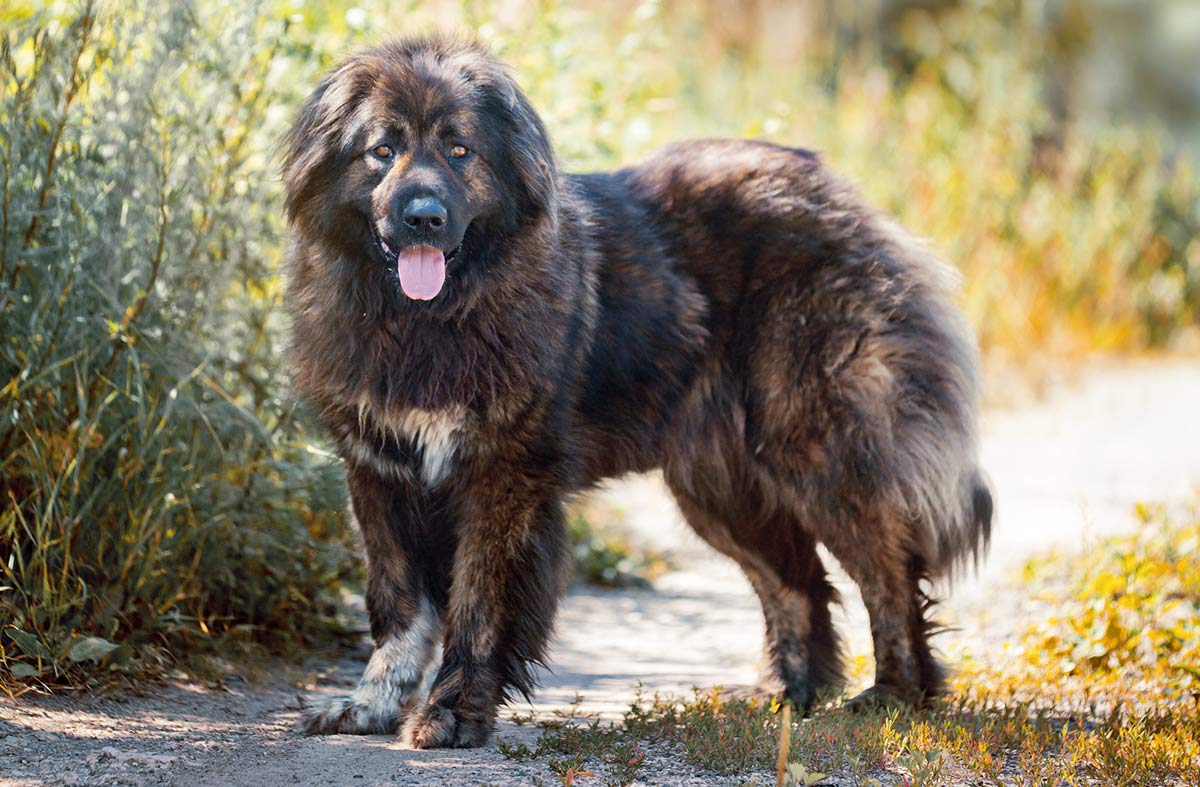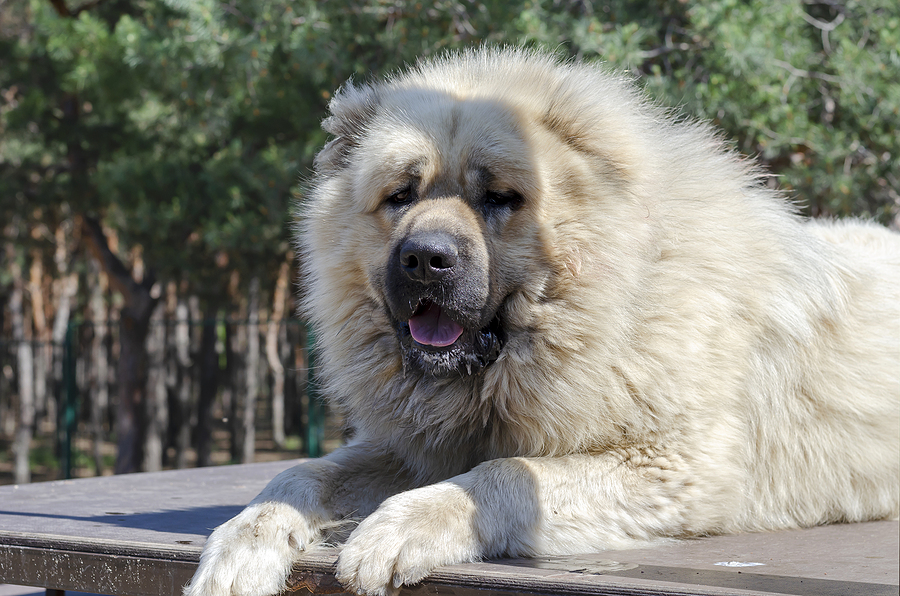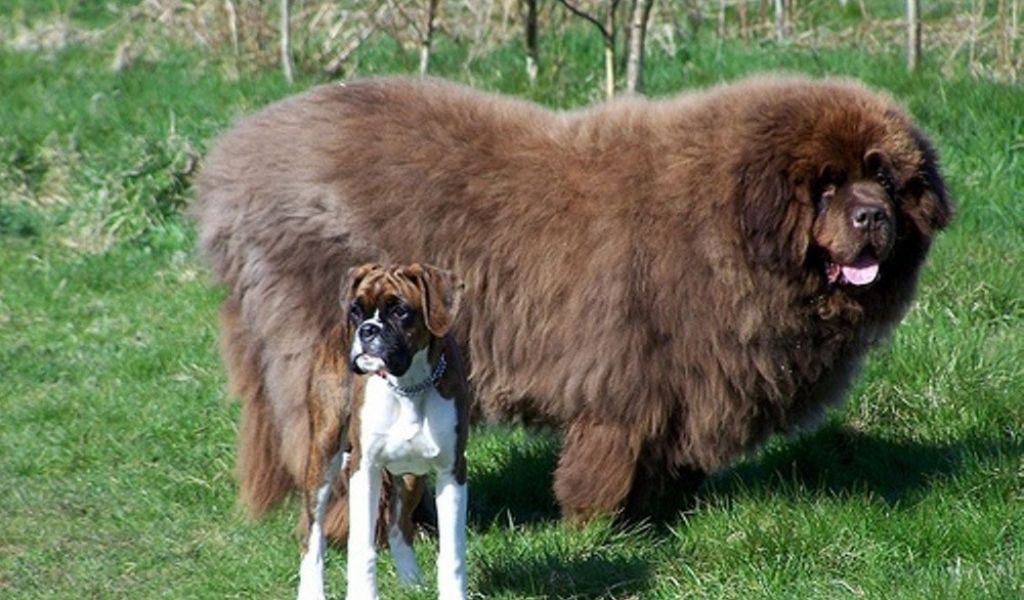The Russian Bear Dog: A Majestic Guardian Unveiled
Step into the world of one of the most formidable and awe-inspiring canine companions: the Russian Bear Dog. This magnificent breed, officially known as the Caucasian Shepherd Dog, hails from the rugged and ancient Caucasus Mountains, embodying centuries of dedication to protection and loyalty. Known for its immense size, powerful presence, and unwavering devotion, the Russian Bear Dog is far more than just a pet; it is a living legacy of guardianship, a breed that commands respect and demands a truly experienced hand.
Often mistaken for a giant, fluffy teddy bear, the Russian Bear Dog's imposing stature and dense coat belie a temperament bred for serious work. These dogs were historically tasked with safeguarding livestock against formidable predators like wolves and bears, a role that has ingrained in them a profound sense of independence, courage, and protective instinct. Understanding this breed means delving deep into its history, appreciating its unique needs, and recognizing the significant commitment required to welcome such a powerful and devoted guardian into your life.
Table of Contents
- Unveiling the Enigmatic Russian Bear Dog: What Exactly Is It?
- A Journey Through Time: The Rich History and Origin of the Russian Bear Dog
- Beyond the Fluff: The Imposing Appearance of the Russian Bear Dog
- Temperament and Intelligence: Understanding the Mind of a Guardian
- Essential Care for Your Russian Bear Dog: Training, Grooming, and Space
- Health and Longevity: A Robust Breed with Specific Considerations
- Is the Russian Bear Dog Right for You? Expert Insights and Common Concerns
- Conclusion: Embracing the Legacy of the Russian Bear Dog
Unveiling the Enigmatic Russian Bear Dog: What Exactly Is It?
When you hear the term "Russian Bear Dog," you're likely referring to the majestic Caucasian Shepherd Dog, a breed known by a multitude of names that reflect its diverse geographical origins and historical roles. Beyond the captivating moniker of "Russian Bear Dog," this breed is also widely recognized as the Caucasian Ovcharka, Caucasian Mountain Dog, Kawkasky Ovtcharka, Baskhan (Karachay) Pariy, Circassian Sheep Dog, Russian Caucasian, and even the Armenian Khobun Dog, or simply "CO." These various names underscore its widespread presence across the Caucasus region, from Georgia and Armenia to Azerbaijan and Dagestan, each contributing to the rich tapestry of its heritage. At its core, the Russian Bear Dog is a giant livestock guardian dog, bred for centuries to be an unwavering protector, a living fortress against any threat to its flock or family. Its unforgettable appearance, often resembling a giant, fluffy teddy bear, is a testament to its unique charm, yet it's crucial not to let this cuddly facade deceive you; beneath the impressive coat lies a powerful and highly instinctual guardian.
A Journey Through Time: The Rich History and Origin of the Russian Bear Dog
The history of the Russian Bear Dog is as vast and rugged as the mountain ranges it calls home. This breed’s lineage traces back thousands of years, evolving naturally in some of the world's most challenging terrains. Its development was not guided by selective breeding for aesthetics, but rather by the relentless demands of survival and protection in harsh environments. This deep-rooted history is fundamental to understanding the breed's inherent traits and its powerful presence today.
Roots in the Caucasus Mountains
The true origin of the Russian Bear Dog lies deep within the ancient landscapes of Eurasia, specifically the Caucasus Mountains. This vast region, encompassing modern-day Georgia, Armenia, Azerbaijan, and Dagestan, served as the crucible for this breed's development. For centuries, these dogs were indispensable companions to shepherds and nomadic tribes, tasked with a singular, vital mission: to protect livestock from formidable natural predators. Wolves, bears, and other large carnivores posed constant threats, and the Caucasian Shepherd, or Russian Bear Dog, was bred to be fearless and independent, capable of taking on these challenges without human intervention. Their very survival depended on their ability to think for themselves, to assess threats, and to act decisively, traits that are still deeply embedded in their temperament today. This historical role as a steadfast guardian against the wilderness shaped their physical prowess, their keen senses, and their unwavering loyalty to their charges.
Evolution in the Soviet Era
While the roots of the Russian Bear Dog are ancient, its more formalized development took place in the Soviet Union starting around 1920. During this period, dogs from the Caucasus Mountains and the steppe regions of Southern Russia were systematically bred to refine the qualities necessary for various working roles. The breed’s incredible strength, intelligence, and protective instincts made it highly valued, not just for livestock guarding, but also for more specialized tasks. They became renowned as prison dogs, utilized for their intimidating presence and formidable guarding capabilities. Furthermore, the Russian military and police employed them for decades, recognizing their versatility as working dogs. It's important to note that while the Black Russian Terrier was specifically created by a Russian kennel for military and police use, the Russian Bear Dog also became a significant part of the broader kennel’s program. These kennels were responsible for employing, training, breeding, and promoting the breed throughout Russia and beyond, cementing its reputation as a highly capable and versatile working canine. This period of structured breeding helped standardize certain characteristics while preserving the core protective nature of the breed.
- Lauren Silverman
- Sydney Sweeney Ass
- Durham Food Hall
- Intercontinental San Francisco
- Hiller Aviation Museum
Beyond the Fluff: The Imposing Appearance of the Russian Bear Dog
The Russian Bear Dog is, without a doubt, one of the most physically impressive dog breeds in existence. Their sheer size and robust build are often the first things that capture attention, immediately conveying their strength and protective capabilities. This is part of why people refer to them as "Russian Bear Dogs" – their imposing presence truly lives up to the name. These dogs fall into the large to giant dog breeds category, with males typically reaching up to 170 pounds and standing an impressive 30 inches tall at the shoulder. While females are slightly smaller, they are no less formidable or impressive in their stature, often weighing between 90 to 140 pounds and standing 26 to 28 inches tall. Their towering build is complemented by a dense, often fluffy coat, which, paradoxically, can make them resemble a giant, cuddly teddy bear. However, this fluffiness should never deceive an observer about their true nature as powerful guardians. The coat length of a Russian Bear Dog can vary significantly, ranging from very long fur to shorter hair, depending on their specific genetics. Some will have extensive feathering, especially on their tails and legs, while medium coats will have some feathering, though not as pronounced. Their coloring is also quite diverse, spanning a beautiful spectrum from pure white to various shades of rust, often with patches of different colors, adding to their unique and captivating appearance. Their size and powerful physique are not merely for show; they are essential attributes that historically enabled them to confront and deter large predators effectively.
Temperament and Intelligence: Understanding the Mind of a Guardian
Understanding the temperament and intelligence of the Russian Bear Dog is paramount for anyone considering this breed. These are not your typical family companion dogs; their minds are wired for a specific purpose, deeply rooted in their history as independent guardians. Their intelligence is undeniable, but it manifests in a way that requires a unique approach to training and integration into a household. They are observant, analytical, and possess a strong will, all traits that served them well in their traditional roles but can pose challenges for an inexperienced owner.
A Protector, Not Just a Pet
The Russian Bear Dog was bred to guard flocks against natural predators, and they still retain many of these traditional instincts today. This means they are inherently protective, territorial, and possess a strong bite. They are one of the most fierce protectors among canines, and their dominant nature demands respect and experience from their human counterparts. For this reason, the Russian Bear Dog only fits into specific families. A new or inexperienced owner is simply not feasible for this breed; they cannot be handled effectively without a deep understanding of canine behavior and the specific needs of a guardian breed. These dogs thrive when they have a job to fulfill, whether it's actual livestock guarding, property protection, or a clearly defined role within the family structure that aligns with their protective instincts. Without proper socialization, consistent training, and clear leadership, their protective instincts can become problematic, leading to aggression towards strangers or other animals. Their formidable nature is a double-edged sword: an incredible asset in the right hands, but a significant challenge in the wrong ones.
Loyalty and Affection: The Other Side of the Coin
Despite their reputation as dominant and dangerous (if mishandled), the Russian Bear Dog possesses a profound capacity for loyalty and affection towards its chosen family. Once they accept you as part of their "flock," they can become incredibly devoted guardians and surprisingly sweet companions. They form deep bonds with their human family members, often displaying a gentle and patient demeanor with children within their own household, though supervision is always essential given their size. Their loyalty is unwavering, and they will go to great lengths to protect those they perceive as their own. This deep devotion is what makes them such effective guardians; their protective instincts are fueled by a powerful bond with their family. However, it’s crucial to remember that this loyalty is often exclusive. While they can be loving and gentle within their inner circle, their natural suspicion of strangers and their strong territorial instincts remain. This duality—fierce protector to outsiders, devoted companion to insiders—is a defining characteristic of the Russian Bear Dog's temperament, making them a unique and complex breed that requires an owner who truly understands and respects their inherent nature.
Essential Care for Your Russian Bear Dog: Training, Grooming, and Space
Caring for a Russian Bear Dog is a significant undertaking that extends far beyond basic feeding and walking. Due to their immense size, powerful instincts, and intelligent yet independent nature, they require a comprehensive approach to training, grooming, and providing adequate space. This breed is not for the faint of heart or those seeking a low-maintenance companion; rather, it demands consistent effort, an understanding of their unique needs, and a commitment to responsible ownership throughout their lifespan. Proper care ensures not only their well-being but also the safety and harmony of your household and community.
Training a Russian Bear Dog requires an experienced hand and begins from puppyhood. Early and extensive socialization is absolutely critical to help them distinguish between a true threat and an innocent visitor. Without it, their natural protective instincts can become overbearing. They need clear, consistent, and firm leadership, but never harshness, as they respond best to respect and positive reinforcement. Their intelligence means they learn quickly, but their independent nature can make them stubborn. Obedience training is not just about commands; it's about establishing a clear hierarchy where you are the trusted leader. Grooming, while seemingly straightforward, is essential, especially for those with longer, fluffy coats. Regular brushing is necessary to prevent matting, reduce shedding, and keep their dense fur healthy. The frequency will depend on the individual dog's coat type, but weekly brushing is often a minimum. Lastly, their sheer size means they require ample space to thrive. A small apartment or a house with a tiny yard is simply inadequate for a dog that can reach 170 pounds and stand 30 inches tall. They need room to move, stretch, and patrol, making a securely fenced large yard or property an absolute necessity. Their historical role as guardians also means they appreciate having a vantage point to survey their domain.
Health and Longevity: A Robust Breed with Specific Considerations
The Russian Bear Dog is generally considered a healthy breed, often boasting a life expectancy of between 10 and 12 years, though some sources specify 10 to 11 years. This relatively long lifespan for a giant breed is partly thanks to responsible breeding practices that have aimed to minimize many unwanted genetic issues over generations. However, like every dog, and particularly like any large or giant breed, Russian Bear Dogs are still susceptible to certain health problems. Understanding these potential issues is crucial for proactive care and ensuring your magnificent companion lives a full, healthy life.
While robust, Russian Bear Dogs are prone to specific health issues commonly seen in large breeds. These include musculoskeletal problems such as hip dysplasia and elbow dysplasia, conditions where the joints don't form correctly, leading to arthritis and pain. Regular veterinary check-ups, maintaining a healthy weight, and providing appropriate nutrition can help manage these risks. Another serious concern for large, deep-chested dogs like the Russian Bear Dog is bloat, or gastric dilatation-volvulus (GDV). This life-threatening condition occurs when the stomach fills with gas and twists, cutting off blood supply. Owners should be aware of the symptoms and seek immediate veterinary attention if bloat is suspected. Obesity is also a common issue, as their large size can make it easy to overfeed them, leading to strain on their joints and other health complications. Despite these specific predispositions, it's often noted that overall, Russian Bear Dogs tend to be healthier than many other purebred dogs, particularly when sourced from reputable breeders who prioritize health screenings. Responsible breeders actively work to breed out known genetic issues, further contributing to the breed's general good health. Regular exercise appropriate for their size and age, a balanced diet, and routine veterinary care are key to mitigating these risks and ensuring your Russian Bear Dog enjoys a long and vibrant life.
Is the Russian Bear Dog Right for You? Expert Insights and Common Concerns
The rising popularity of Russian Bear Dogs as pets has brought with it a host of common concerns and expert insights that prospective owners must seriously consider. While their imposing beauty and fierce loyalty are undeniably appealing, the truth is that the Caucasian Shepherd Dog, or Russian Bear Dog, is not the right breed for everyone. This is a significant commitment, demanding a specific type of owner and lifestyle to ensure the dog's well-being and the safety of those around it. Understanding these nuances is critical before making the decision to bring one of these magnificent creatures into your home.
As highlighted throughout this article, the Russian Bear Dog is not your usual family companion dog. They were bred for centuries to be independent, dominant, and fearless protectors, traits that require an owner with considerable experience and a deep understanding of canine behavior. A new or inexperienced owner is simply not feasible for this breed, as they cannot be handled effectively without the necessary knowledge and confidence. Their strong protective instincts, coupled with their sheer size and power, mean that consistent training, early and extensive socialization, and firm, fair leadership are non-negotiable. Without these, their guarding instincts can manifest as aggression towards strangers, other animals, or even unintended targets. Common concerns often revolve around their potential for aggression if not properly managed, their significant space requirements, and the time commitment needed for their training and socialization. Expert insights consistently emphasize that the ideal owner for a Russian Bear Dog is someone who is experienced with large, dominant breeds, has a securely fenced property, and is committed to lifelong training and socialization. When considering acquiring one, always ask for referrals from people who own a Russian Bear Dog and, crucially, visit the breeder's facilities. A reputable breeder will be transparent about the breed's challenges, prioritize health and temperament, and be selective about who they sell their puppies to, ensuring a good match. This due diligence is vital for both your family's safety and the dog's welfare, ensuring this impressive guardian finds the right home where it can thrive.
Conclusion: Embracing the Legacy of the Russian Bear Dog
The Russian Bear Dog, or Caucasian Shepherd Dog, stands as a testament to centuries of natural selection and dedicated breeding, resulting in a canine companion of unparalleled power, loyalty, and protective instinct. From its ancient origins in the rugged Caucasus Mountains, guarding livestock against formidable predators, to its more formalized roles in the Soviet era, this breed has consistently proven itself as a devoted guardian. Its imposing size, magnificent coat, and profound temperament make it a truly unforgettable presence, a dog that demands respect and commands attention.
While the allure of owning such a majestic creature is undeniable, it is crucial to remember that the Russian Bear Dog is not a breed for everyone. Its dominant nature, independent spirit, and intense protective instincts necessitate an experienced, committed owner who understands the intricacies of canine behavior and is prepared to provide consistent training, extensive socialization, and ample space. For the right individual or family, one who embraces the challenge and respects the breed's unique heritage, the Russian Bear Dog will become an incredibly loyal, sweet, and unwavering protector, a cherished member of the family. If you've been captivated by the powerful legacy of the Russian Bear Dog, we encourage you to delve deeper into responsible ownership. Share your thoughts in the comments below, explore more articles on guardian breeds, and connect with experienced Russian Bear Dog owners to learn from their insights. The journey with a Russian Bear Dog is a profound one, offering a bond unlike any other, rooted in mutual respect and unwavering devotion.
- Travel Town Free Energy
- Math Meme
- Kirstentoosweet Leaked
- Good Good Culture Club
- %ED%8F%B0 %EB%B2%84%EB%B8%8C

Russian Bear Dog - A Complete Guide To The Caucasian Shepherd

Russian Bear Dog - Everything you need | DogsGossip.com

Russian Bear Dog / myLot